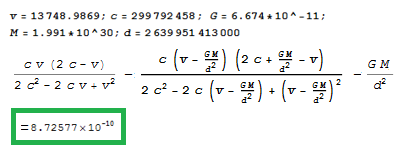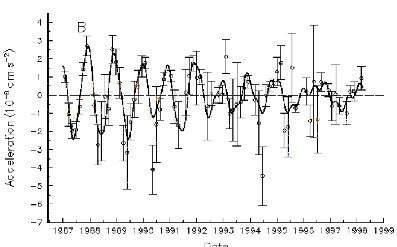
Based on the anomalous acceleration acting on Pioneer 10 with a magnitude of 8.7×10-10 m/s² directed towards the Sun, we can demonstrate that there is serious indication that the anomaly is due to the use of a wrong Doppler shift formula by the NASA Jet Propulsion Laboratory (JPL).
Indeed if we compare the result given by the formula used by JPL based on the Einstein’s second postulate, and the result given by the classic Galilean velocity addition formula, we found exactly the value of the anomalous acceleration acting on Pioneer 10 toward the Sun.
I – How did JPL discovered the ∼8 ×10−10 m/s2 anomalous acceleration?
In the Pioneer 10 mission a ground station was sending a radio signal with frequency ft to the probe, then the signal was sending back synchronously to the ground station which received it at the frequency fr.
With the Doppler shift of the radio signal, JPL was able to calculate very precisely the speed of the probe, and with the evolution of the speed they had the acceleration which was more precisely a deceleration as the probe was attracted by the whole Solar system.
With that attraction, according to the universal law of gravitation and the well-known positions of the Sun, planets and all masses in the solar system, they calculated very precisely how far was the probe from us.
The problem is that one second later the velocity of the probe should have decelerated of exactly that gravity attraction they just calculated, but no, it has decelerate a small amount more, very small, ∼ 8.7 ×10−10 m/s2, but still, it was not normal.
II – Relativistic Doppler shift formula used by JPL
The formula used by JPL was the well-known relativistic Doppler shift formula which is:

With fs the sent frequency, fr the received frequency, β=v ⁄ c and v the velocity between the emitter and the receptor.
As there is two way for the signal, up to the probe, and down sent back synchronously to the ground station, the total round trip formula is:

And with that JPL was able to deduce the velocity v of the probe:

III – Classic Galilean Doppler shift formula:
For the way up of the signal to the probe, with v the velocity of the probe going away from the Earth, (let’s temporary consider that the Earth is stationary with the Sun as we will see that it’s equilibrates itself on the long-term, evolving from -30 km.s-1 to +30 km.s-1) the formula is:

For the return trip of the signal, in the classical Galilean referential, the probe is stationary and is sending the signal with the speed of c in its reference frame toward the Earth which is moving away from it with the velocity v, so the return formula is the same, and total round trip formula is:

Let’s consider that the Galilean formulas are the good one. In that case JPL would still calculate the probe velocity with (3) but the received frequency fr would depend of a different « real velocity » than the one found by JPL and we can express the velocity calculated by JPL, Vjpl with the « real velocity » v of the probe (two different velocity, one « real » and, from it, another one « calculated by JPL ») :

Which can be simplified not depending of the sent frequency fs to:

IV – Solar system attraction calculation:
The solar system is attracting the probe with the respect of the universal gravitation law with all its masses M and the distance d to the probe:

As (8) is the real acceleration, each second the real velocity is changing to v – a and the velocity calculated by JPL Vjpl expressed with the real velocity is changing to:

At the beginning JPL simply observed the deceleration with vjpl – vjpl2 which is (7) – (9) and deduced from that deceleration the distance between Pioneer 10 and the solar barycenter. Then each second after the two values, the velocity changing and the gravity should began to match every seconds.
But the attraction found with the JPL velocity variation was always bigger than the gravity attraction… And one of the first time they study precisely that anomalous acceleration, in the beginning of 1979, when the distance of the probe was 2 639 951 413 000 m and its velocity 13 748.9869 m.s-1 (source NASA Horizon) they found 8.74 ×10−10 m/s2 more toward the Sun in the velocity variation than in the gravity.
And if JPL did a mistake using relativistic formula (3) instead of classic Galilean formula (5) then the mistake is exactly equal to:
(7) – (9) – (8)
Doing the calculation (thanks to Wolfram!) we found:

Which is almost exactly what JPL found at the epoch.
V – Decreasing difference
Now if we change for the velocity and distance of almost two months later so for example February the 21th of 1979 with v= 13729.7344 m.s-1 and d = 2 701 676 943 000 we now found an anomaly of only 8.32453.10-10 m/s2
And more than two year and a half later on October the 10th of 1981, v = 13 360.8107 m.s-1, d = 3 827 209 369 000 and we find less than half of what we add at the beginning: 4.08073.10-10 m/s2
The difference between the speed variation and the gravitation is exponentially decreasing:

But they naturally thought that this offset of unknown origin should be constant at around 8.7.10-10 m.sec-2. In the total absence of explanation on the origin of a phenomenon that was found precisely on a certain date we are inclined to think that it will be exactly the « same value » later as it’s the « same phenomenon ».
And from that moment they began to literally search this exactly offset of 8.7.10-10 m.sec-2 in all subsequent calculations. But the anomaly was less and less important in reality. This is a rather exemplary case of the experimenter effect, where a scientist makes his experimental results tend towards the result he seeks.
VI – Earth movement
At this point, and in those new conditions, it’s important to remind that the up trip of the signal, from Earth to the probe, is potentially influenced by the velocity of the Earth around the Sun from -30 km.s-1 to +30 km.s-1 depending on the period of the year.
Here is the well identified by JPL Doppler shift year variation due to the Earth movement:

Even if the variation equilibrate itself in average from -30 km.s-1 to +30 km.s-1 I’m not sure to well understand why it has not been also considered as an anomaly at the epoch…
VII – Conclusion
Changing the relativistic formula (3) for the classic Galilean formula (5) in the Doppler shift calculation is equivalent to say that the electromagnetic wave obey to the velocities addition in a Galilean referential in some certain conditions (vacuum, no gravity, …).
Anderson wisely speculated that this would be interesting if the Pioneer anomaly was new physics, and perhaps after studying more deeply the hypothesis proposed in this article we’ll have to change the second postulate to something like:
Electromagnetic wave obey to the velocity addition and are emitted by the matter which produce them at the exact speed of c in their reference frame and in vacuum (without any Lorentz transformation of course).
We will have to study also if, has I think, in the case of a reflection, the new law apply on the emitted signal by the mirror, whatever the incoming signal velocity is.




